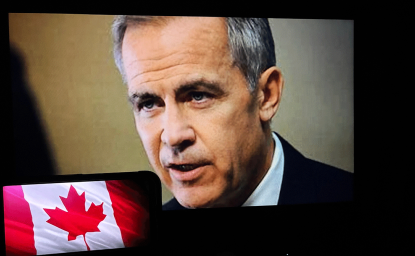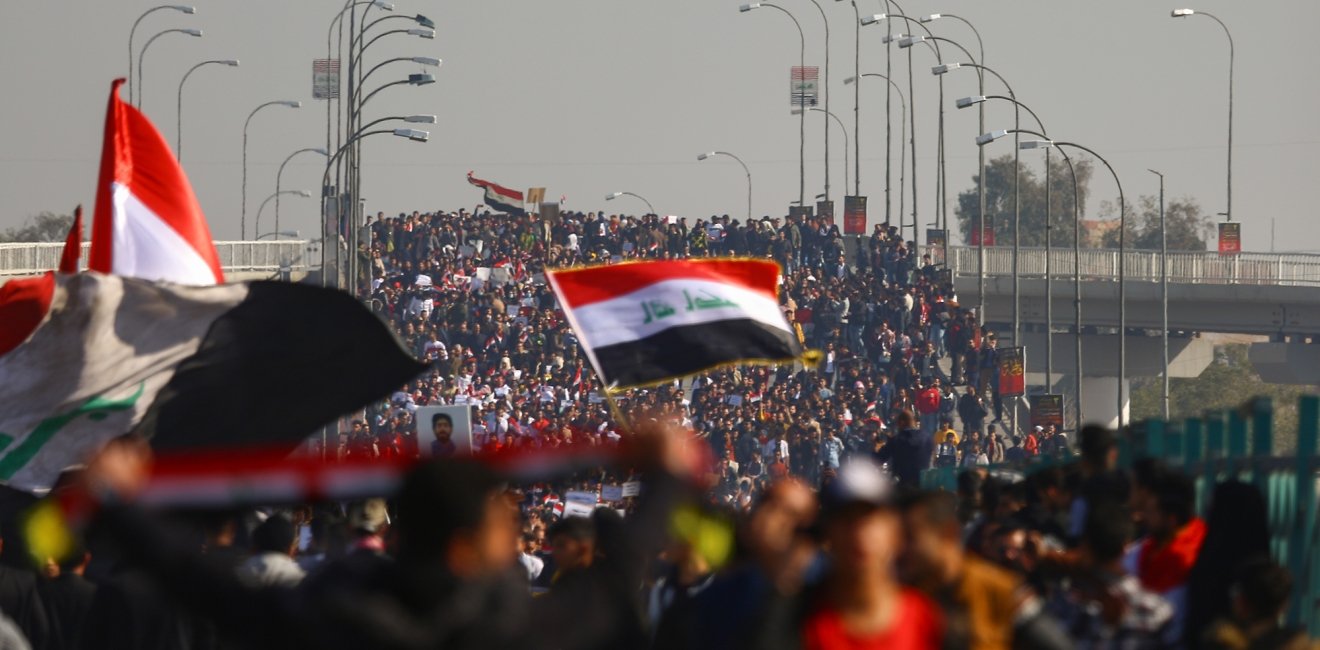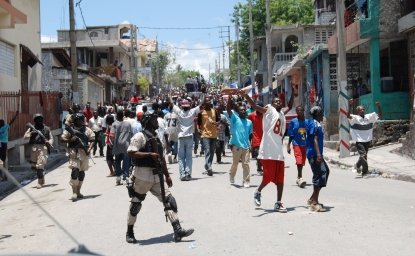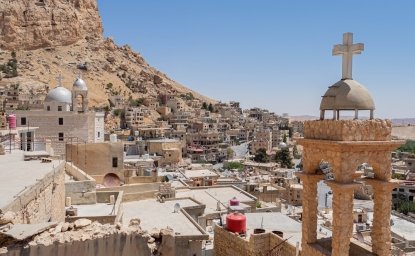On April 9th, the seventeenth anniversary of the fall of the regime of Saddam Hussain, President Barham Salih assigned the task of forming a new government to the head of National Intelligence Mustafa al-Kadhimi. If he was doing his job well in the last three years, the Prime Minister Designate will know very well what kind of a mess he is getting himself into.
Iraq teeters on the edge of a cliff. It has come a long way, but mostly downhill. Iraq now is a weakened state, which has been hollowed out and turned into an elaborate façade. There is a dysfunctional government manipulated by a behind-the-scenes power structure built on corruption and loyalty to Iran. This malign power structure is underpinned by militias answerable to and armed by the Islamic Revolutionary Guards Corps (IRGC) of Iran. There are areas around Baghdad and at the border with Syria which are off limits to the regular Iraqi security forces and are controlled exclusively by those militias. These areas are used, among other things, to house their own prisons and torture chambers and to store their rockets and other armaments.
Iraq now is a weakened state, which has been hollowed out and turned into an elaborate façade.
Contrary to the letter and spirit of the constitution which forbids any discrimination between citizen on religious or racial grounds, Islamist political parties, aided and encouraged by Iran constructed a political system based on sectarian and racial divisions called Muhasasa. This system enshrines sectarian and ethnic divisions and acts as a vehicle for sectarian discrimination. Under this system, the judiciary has been politicized and intimidated and is incapable of acting independently, meaning that no penalty or provision of national legislation can be effectively applied across the land. Rule of law remains a distant dream.
The security situation is also severely compromised. Assassinations, kidnappings and intimidation are commonplace, and the latent threat of a resurgent ISIS is evident through frequent guerilla attacks, which have never quite ceased despite the support of the Coalition. The lack of progress in recovery and reconstruction after the defeat of ISIS, exemplified by hundreds of thousands of displaced families and major cities still in ruin, especially in the western region, is also poisoning the hope for stability and spells humanitarian disaster and threatens the return of extremism in years to come.
However, the story that captured the media and the world’s attention of late has been the large and persistent protests in Baghdad and the southern Shia region that began last October out of near total exasperation with the current system of government – now on hold due to the coronavirus pandemic, but left with much unfinished business. These demonstrators were mobilizing against Iran’s domination and the rampant and blatant corruption throughout state institutions, leading to failure in delivering key public services including but not limited to security, housing, health, education, electricity, and water. Employment opportunities are scarce, particularly among the youth, which is now compounded by a severe economic crisis resulting from the collapse in oil prices – still the almost exclusive source of government revenue. This shocking scene was already playing out as the onslaught of the coronavirus pandemic set in, making a desperate situation worse. Not a pretty picture.
This degenerative state of affairs has been sustained by fear generated by sectarian politics and intimidation by militias coupled with a web of interests woven by a kleptocratic political class in control of the organs and treasures of the state – that it can direct at will. Other factors which have prevented reform are America’s relative indifference and the absence of strong opposition and competent leaders, most of whom have fled the country.
This degenerative state of affairs has been sustained by fear generated by sectarian politics and intimidation by militias...
The main beneficiary of this situation has been Iran. Iran has been using Iraq as a milking cow to circumvent US sanctions, as a corridor to continue its activities in Syria and Lebanon and as a buffer in case of a military confrontation with the US. But the strained equilibrium of the last decade of Iraqi chaos now threatens to snap. Here is why.
Iran is now weaker than it was in 2003. And it is getting weaker still with time. Its grip on Iraq is loosening, especially after the killing of General Soleimani in January by a US drone strike. Iraqi public opinion, once divided and manipulated by sectarian sentiments, has swung decisively against Iran and the status quo – witness the burning of Iranian consulate in Najaf which was previously the unchallenged center of their sectarian Shia support. The national budget is now turned upside down due to the drastic fall in oil prices. The 2020 budget was prepared on the assumption that the price of oil would average around 55 USD per barrel. Now we would be lucky if it averages 30 USD. Increasingly desperate conditions have sparked infighting between the groups loyal to Iran including both militias and Islamist parties.
The uprising which erupted last October demanded a root-and-branch reform of the political system. It was a mass movement lead primarily by the youth. Repeated attempts to crush it failed. Several hundred unarmed protesters were shot and killed by snipers, military-grade teargas canisters and other lethal weapons. Tens of thousands of others were injured and maimed. But the peaceful unarmed protesters persisted and brought about the resignation of Prime Minister Adil Abdul-Mahdi. Now there is a lull precipitated by the coronavirus lockdown. It is likely that this is the calm before the storm. And the coming storm may well be more violent than the one that started last October.
Meanwhile, political commentators are busy trying to assess the chances of Prime Minister Designate Kadhimi to form his government and get approval from parliament. This, in my view, is not so important. It is like rearranging furniture on the Titanic. We should be looking at the bigger picture and trying to make out the icebergs ahead.
Iran is weakened but fully engaged and its instruments are still potent. A weak and engaged player can be more effective than a powerful but disengaged one. Iran’s strategic plan seems to be to get the American military to pull out from Iraq, utilizing political and security pressure and counting on President Trump’s apparent inclination to withdraw from the region. Their attitude to President Trump is not to deal with him but to wait him out. With the US and allies out of the way ISIS could go on the offensive. Iran would find in that an opportunity to reactivate sectarian fears, divisions and clashes which have largely subsided in Iraq. A civil war could ensue. This would bring about the end of the uprising by crushing the stubborn protesters leading to a consolidation of control by Iran over the political and security apparatus in Iraq.
Iran is weakened but fully engaged and its instruments are still potent. A weak and engaged player can be more effective than a powerful but disengaged one.
Unless, that is, they are stopped.
Here is where the role of the US is crucial. It will not be the only deciding factor, but it will be very important. The general perception in Iraq is that the United States no longer cares. This needs to change. The recent statement on April 13 by Secretary of State Mike Pompeo seems to indicate a better awareness of what is going on than we had witnessed from the State Department before. He concluded his statement by saying: “We stand with Iraqi people as they seek a sovereign, prosperous Iraq, free from corruption and terror”. Almost identical language to the demands of the uprising. The US must not withdraw its military, and must increase the pressure on the Iranian militias, and their leaders, some of whom already designated by the US as terrorists. The Iraqi people, knowing that the US is countering an Iranian takeover, would take care of the rest.
If things go well, political Islam would be weakened in the region and allow for a stronger alliance with the US and the West. This would enable the flow of resources and expertise that would give Iraqi people the chance they desperately need to recover and rebuild their country and make it work for all its citizens.
If things go in the wrong direction however, Iraq would represent a strategic victory for Iran, and a source of endless trouble for the world and untold suffering for its people.
The views expressed in this article are those of the author and do not reflect an official position of the Wilson Center.
Author
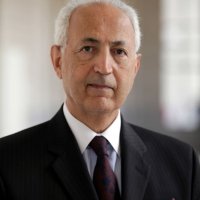
Former Iraqi Ambassador to the United Nations; Former Iraqi Ambassador to the United States

Middle East Program
The Wilson Center’s Middle East Program serves as a crucial resource for the policymaking community and beyond, providing analyses and research that helps inform US foreign policymaking, stimulates public debate, and expands knowledge about issues in the wider Middle East and North Africa (MENA) region. Read more

Explore More
Browse Insights & Analysis
MENA360°
